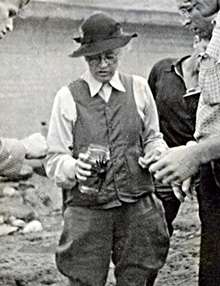Myrtle E. Johnson
Myrtle Elizabeth Johnson (1881 – 1967) was an American marine biologist, ascidiologist, and educator in California in the early 20th century. She was the first woman PhD faculty member at the San Diego State College (now San Diego State University) and was chair of the Biology department for two decades. Her major work, Seashore Animals of the Pacific Coast, published in 1927, was the standard descriptive text of intertidal species until Ed Ricketts's Between Pacific Tides was published in 1939.[1] Ricketts considered Johnson's book "the vade mecum of marine biologists of the Pacific."[2]
Myrtle E. Johnson | |
|---|---|
 Johnson leads SDSU biology students on a field trip to Bird Rock, La Jolla, in 1937. | |
| Born | June 4, 1881 East Troy, Wisconsin, United States |
| Died | August 17, 1967 (aged 86) San Diego, California, United States |
| Citizenship | United States |
| Alma mater | University of California, Berkeley |
| Known for | Seashore Animals of the Pacific Coast |
| Scientific career | |
| Fields | Marine Biology |
| Institutions | San Diego State University |
Biography
Johnson was born on June 4, 1881, in East Troy, Wisconsin to Marian Gray Johnson and Dr. Theodore F. Johnson. In 1887, the Johnson family moved to National City, south of San Diego, for the doctor's health.[3] Johnson attended San Diego State Normal School (now San Diego State University), graduating with a teaching credential in 1901. She taught in elementary and junior high schools in south San Diego, Palomar, and the Los Angeles city schools, before matriculating at the University of California, Berkeley in 1904. Johnson received her B.S. in Math and Zoology in 1908, and an M.S. in Zoology (with a secondary teaching credential) in 1909. She worked as a research assistant to William Ritter at the Marine Biological Association in La Jolla (1909-1910)[4] before continuing post-graduate study in Zoology, working with Dr. Harry Beal Torrey. She received her PhD (Zoology) in 1912.
While working as a high school biology teacher in Pasadena (1912-1921), Johnson began work (1915) on a study of intertidal species with another Pasadena high school biologist, Harry James Snook. They continued to work on the text after Johnson joined the faculty of San Diego State College in 1921. Johnson and Snook's Seashore Animals of the Pacific Coast was first published in 1927 and has been reissued in three editions (1935, 1955, 1967).[5]
Johnson died on August 17, 1967 in San Diego.
Career
- William Ritter
- Ed Ricketts
- Harry Beal Torrey
- Harry James Snook
Professional Societies
- Member and Fellow, American Association for the Advancement of Science
- Member and Fellow, California Academy of Sciences
- Member and Fellow, San Diego Society of Natural History
Memberships
- San Diego Fine Art Society
- San Diego Zoological Society
- Sierra Club
- Audubon Society
- Cooper Ornithological Society
- National Parks Conservation Association (formerly National Parks Association)
- Biological Photographic Association
- University Women’s Club
- National Education Association (Life member)
- National Association for Research in Science Teaching (Life member)
- Alpha Delta Gamma
Selected bibliography
- Johnson, Myrtle E. (1937). West coast marine shells. Ann Arbor, Mich.: Edwards Brothers.
- Johnson, Myrtle E; Harwood, Robert D; Harvey, Dorothy R; Crouch, James E (1936). How living things get food. Sacramento: Published by California State Dept. of Education?: California State Printing Office.
- Johnson, Myrtle E.; Snook, Harry James (1927). Seashore animals of the Pacific coast. New York: Macmillan Company.
- Johnson, Myrtle E. (30 November 1920). "Salt water aquaria for the school laboratory". School Science and Mathematics. 20 (9): 779–781. doi:10.1111/j.1949-8594.1920.tb07875.x.
- Johnson, Myrtle E. (1913). The control of pigment formation in amphibian larvae (dissertation). Berkeley: University of California Press.
- Ritter, William E.; Johnson, Myrtle E. (1912). "The growth and differentiation of the chain of cyclosalpa affinis". Journal of Morphology. 22. doi:10.1002/jmor.1050220209.
- Johnson, Myrtle E. (1909). "A quantitative study of the development of the salpa chain (Salpa Fusiformis Runcinata)". Cite journal requires
|journal=(help)
References
- Tamm, Eric Enno (2004). Beyond the Outer Shores: The Untold Odyssey of Ed Ricketts, the Pioneering Ecologist Who Inspired John Steinbeck and Joseph Campbell. New York: Thunder's Mouth Press. p. 28.
- Ricketts, Edward Flanders; Calvin, Jack (1939). Between Pacific Tides. An account of the habits and habitats of some five hundred of the common, conspicuous seashore invertebrates of the Pacific Coast between Sitka, Alaska, and Northern Mexico. Stanford University Press.
- Pruitt, Clarence M. (December 1, 1967). "Myrtle Elizabeth Johnson". Science Education. 51 (5): 424–427. doi:10.1002/sce.3730510503.
- "Guide to the William E. Ritter Papers, 1879-1944." Finding Aid (BANC MSS 71/3 c ed.). Berkeley, CA: Bancroft Library, University of California, Berkeley.
- Formats and editions of 'Seashore animals of the Pacific coast'. OCLC. OCLC 816334.
External links
- Johnson, Myrtle E. "Guide to the Myrtle Elizabeth Johnson Papers". San Diego, Calif.: San Diego State University Special Collections and University Archives. Retrieved October 29, 2014 – via Online Archive of California.